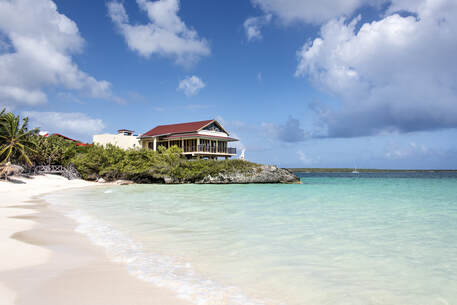Crystal clear and warm waters await you at Maria La Gorda Beach (Mary the Fat).

This is one of Cuba’s most beautiful beaches, located on Corrientes Bay, on the Guanahacabibes Peninsula, 93 miles (150 km) west of the city of Pinar del Rio and 188 miles (304 km) from Havana. According to history, in one of the trips made by the pirates, to the Cuban coasts, a woman named María was abandoned in a beach of the Guanahacabibes Peninsula. After time, this attractive place was named after the unfortunate lady. Nowadays, María La Gorda beach is famous for its underwater activities and the International Scuba Diving Center is located there. This impressive beach is now popular for its serenity and sense of privacy.
The beautiful beach, with fine sand, is five miles (8 km) long.The seabed here is one of the richest in Cuba in terms of biodiversity and has the largest colony of black coral in the archipelago. At its 39 scuba-diving sites, you can see gardens of gorgonians, sponges, a long wall with grottoes, abundant marine fauna and artefacts showing that both pirate and merchant ships used to anchor here in the past.
Enjoy scuba diving and underwater photography? María La Gorda is the place to be! Scuba diving (for both professionals and beginners) is the main activity at Maria La Gorda, together with underwater photography, with modern equipment and assistance from divers whose skill is attested to by the World Underwater Federation (CMAS). However, the area's tranquility, fine white sandy beaches, many coconut palm trees and setting (with great natural and archeological attractions) offer many other options as well: sunbathing, swimming, other water sports, seafaris, lazing around, reading, hiking, ecotourism, bird-watching, nature walks and excursions to other points of interest on the Guanahacabibes Peninsula.
Explore María La Gorda, on the Bahía de Corrientes, beginning in La Bajada. Meet with a local naturalist at Guanahacabibes National Park, the largest of Cuba’s six nature reserves. In addition to butterflies and bird life such as the endemic bee hummingbird and yellow-headed warbler, Guanahacabibes is home to a large profusion of orchids and epiphytes with a total of 16 species, some indigenous and some recently discovered. At a Meteorological Center, learn about forecasting weather patterns, storms and hurricanes that have left their mark in Cuba, along with how historic storms have impacted ordinary Cubans. Participate in an expert discussion at the “Honey House” on beekeeping and honey production.
The beautiful beach, with fine sand, is five miles (8 km) long.The seabed here is one of the richest in Cuba in terms of biodiversity and has the largest colony of black coral in the archipelago. At its 39 scuba-diving sites, you can see gardens of gorgonians, sponges, a long wall with grottoes, abundant marine fauna and artefacts showing that both pirate and merchant ships used to anchor here in the past.
Enjoy scuba diving and underwater photography? María La Gorda is the place to be! Scuba diving (for both professionals and beginners) is the main activity at Maria La Gorda, together with underwater photography, with modern equipment and assistance from divers whose skill is attested to by the World Underwater Federation (CMAS). However, the area's tranquility, fine white sandy beaches, many coconut palm trees and setting (with great natural and archeological attractions) offer many other options as well: sunbathing, swimming, other water sports, seafaris, lazing around, reading, hiking, ecotourism, bird-watching, nature walks and excursions to other points of interest on the Guanahacabibes Peninsula.
Explore María La Gorda, on the Bahía de Corrientes, beginning in La Bajada. Meet with a local naturalist at Guanahacabibes National Park, the largest of Cuba’s six nature reserves. In addition to butterflies and bird life such as the endemic bee hummingbird and yellow-headed warbler, Guanahacabibes is home to a large profusion of orchids and epiphytes with a total of 16 species, some indigenous and some recently discovered. At a Meteorological Center, learn about forecasting weather patterns, storms and hurricanes that have left their mark in Cuba, along with how historic storms have impacted ordinary Cubans. Participate in an expert discussion at the “Honey House” on beekeeping and honey production.